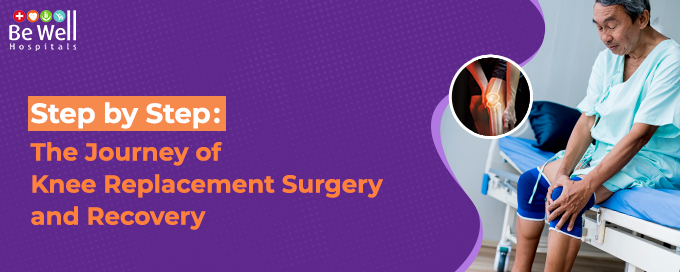Step by Step: The Journey of Knee Replacement Surgery and Recovery

Knee Replacement
Introduction
Welcome to a comprehensive guide on the transformative process of knee replacement surgery and the vital journey of recovery that follows. In this blog post, we embark on an illuminating exploration of the world of knee replacement, offering you a detailed overview of this life-changing procedure. From the initial decision-making to the surgical theatre, and beyond to the realms of recovery, this post serves as your compass to navigate the entire terrain. We delve into the intricate procedure of knee replacement surgery, shedding light on its steps and significance.
With a firm commitment to equipping you with knowledge and insights, our purpose here is to guide you through the step-by-step journey, enabling you to comprehend the procedure, embrace the recovery process, and embark on a path to restored mobility and vitality.
Preparing for Knee Replacement Surgery
Preparing for Knee Replacement Surgery involves several essential steps to ensure a smooth and successful procedure.
Step 1: Scheduling a Consultation with the surgeon, where the patient can discuss their medical history, current condition, and any concerns they might have. Following this, a series of Medical tests and evaluations will be conducted to assess the patient's overall health and determine their candidacy for the surgery.
Step 2: During these consultations, the surgeon will also delve into discussing anesthesia options, explaining the various choices available and helping the patient make an informed decision based on their comfort and medical needs.
Step 3: The surgeon will provide Pre-operative instructions, which may include guidelines for medication, diet, and other preparations to optimize the surgical outcome and ensure the patient's well-being before, during, and after the knee replacement surgery.
The Surgical Procedure
The Surgical Procedure of knee replacement is a meticulously orchestrated process designed to alleviate pain and improve mobility. During consultations, patients receive a comprehensive Explanation of the process, where the surgeon outlines the steps involved and addresses any concerns. The Two Primary Knee Replacement Surgeries
Different techniques may be used based on the patient's condition, such as minimally invasive approaches that result in smaller incisions and potentially quicker recovery. The Duration of the procedure varies but typically ranges from one to three hours, depending on factors like the complexity of the surgery and the technique employed. Overall, understanding the nuances of the Surgical Procedure empowers patients to make informed decisions and embark on their journey to a more comfortable and active life.
The Recovery Process
The Recovery Process after knee replacement surgery involves several crucial elements aimed at ensuring a smooth rehabilitation and optimal outcomes:
By focusing on these aspects of the recovery process, patients can enhance their overall well-being and successfully regain their quality of life after knee replacement surgery.
Life After Knee Replacement Surgery: Maintaining a Healthy Lifestyle
Receiving a knee replacement surgery is a significant step towards regaining mobility and reducing pain. Here's a comprehensive guide on how to navigate life after knee replacement surgery:
Maintenance of a Healthy Lifestyle:Appropriate Exercises to Maintain the Knee Replacement:
Risks and Complications to Watch Out For:
By adopting a healthy lifestyle, staying committed to appropriate exercises, and remaining vigilant about potential risks, you can enhance your chances of enjoying a pain-free and active life with your new knee joint.
Conclusion
The journey through life after knee replacement surgery is one of transformation and renewed vitality. As we recap the steps outlined above, it becomes evident that the path to recovery requires commitment, dedication, and a positive outlook. The importance of the recovery process cannot be overstated, it's a period of immense growth, both physically and mentally. For those currently undergoing knee replacement surgery, it's important to remember that every challenge is an opportunity to emerge stronger.
As you navigate this journey, consider consulting Knee Replacement Surgeons at Be Well Hospitals. Their expertise and dedication can be a guiding light as you work towards regaining mobility and embracing a fuller, more active life.
